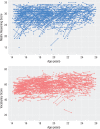Mutualistic Coupling Between Vocabulary and Reasoning Supports Cognitive Development During Late Adolescence and Early Adulthood
- PMID: 28787239
- PMCID: PMC5641983
- DOI: 10.1177/0956797617710785
Mutualistic Coupling Between Vocabulary and Reasoning Supports Cognitive Development During Late Adolescence and Early Adulthood
Erratum in
-
Corrigendum: Mutualistic Coupling Between Vocabulary and Reasoning Supports Cognitive Development During Late Adolescence and Early Adulthood.Psychol Sci. 2019 Jun;30(6):955-959. doi: 10.1177/0956797619843895. Epub 2019 Apr 24. Psychol Sci. 2019. PMID: 31017832 Free PMC article. No abstract available.
Abstract
One of the most replicable findings in psychology is the positive manifold: the observation that individual differences in cognitive abilities are universally positively correlated. Investigating the developmental origin of the positive manifold is crucial to understanding it. In a large longitudinal cohort of adolescents and young adults ( N = 785; n = 566 across two waves, mean interval between waves = 1.48 years; age range = 14-25 years), we examined developmental changes in two core cognitive domains, fluid reasoning and vocabulary. We used bivariate latent change score models to compare three leading accounts of cognitive development: g-factor theory, investment theory, and mutualism. We showed that a mutualism model, which proposes that basic cognitive abilities directly and positively interact during development, provides the best account of developmental changes. We found that individuals with higher scores in vocabulary showed greater gains in matrix reasoning and vice versa. These dynamic coupling pathways are not predicted by other accounts and provide a novel mechanistic window into cognitive development.
Keywords: cognitive development; fluid reasoning; longitudinal modeling; mutualism; open data; vocabulary.
Conflict of interest statement
Figures





Similar articles
-
Mutualistic coupling of vocabulary and non-verbal reasoning in children with and without language disorder.Dev Sci. 2022 May;25(3):e13208. doi: 10.1111/desc.13208. Epub 2022 Feb 7. Dev Sci. 2022. PMID: 34862694 Free PMC article.
-
Mutualistic Coupling Between Vocabulary and Reasoning in Young Children: A Replication and Extension of the Study by Kievit et al. (2017).Psychol Sci. 2019 Aug;30(8):1245-1252. doi: 10.1177/0956797619841265. Epub 2019 May 17. Psychol Sci. 2019. PMID: 31100049 Free PMC article.
-
Theory of mind development from adolescence to adulthood: Testing the two-component model.Br J Dev Psychol. 2020 Jun;38(2):289-303. doi: 10.1111/bjdp.12320. Epub 2020 Jan 20. Br J Dev Psychol. 2020. PMID: 31960462
-
The stability of cognitive abilities: A meta-analytic review of longitudinal studies.Psychol Bull. 2024 Apr;150(4):399-439. doi: 10.1037/bul0000425. Epub 2024 Feb 8. Psychol Bull. 2024. PMID: 38330347 Free PMC article.
-
Fuzzy-trace theory: dual processes in memory, reasoning, and cognitive neuroscience.Adv Child Dev Behav. 2001;28:41-100. doi: 10.1016/s0065-2407(02)80062-3. Adv Child Dev Behav. 2001. PMID: 11605365 Review.
Cited by
-
Why Do Bi-Factor Models Outperform Higher-Order g Factor Models? A Network Perspective.J Intell. 2024 Feb 4;12(2):18. doi: 10.3390/jintelligence12020018. J Intell. 2024. PMID: 38392174 Free PMC article.
-
Inferring latent learning factors in large-scale cognitive training data.Nat Hum Behav. 2020 Nov;4(11):1145-1155. doi: 10.1038/s41562-020-00935-3. Epub 2020 Aug 31. Nat Hum Behav. 2020. PMID: 32868884
-
How to capture developmental brain dynamics: gaps and solutions.NPJ Sci Learn. 2021 May 3;6(1):10. doi: 10.1038/s41539-021-00088-6. NPJ Sci Learn. 2021. PMID: 33941785 Free PMC article.
-
Integrated Intelligence from Distributed Brain Activity.Trends Cogn Sci. 2020 Oct;24(10):838-852. doi: 10.1016/j.tics.2020.06.012. Epub 2020 Aug 5. Trends Cogn Sci. 2020. PMID: 32771330 Free PMC article. Review.
-
Grey and white matter metrics demonstrate distinct and complementary prediction of differences in cognitive performance in children: Findings from ABCD (N= 11 876).bioRxiv [Preprint]. 2023 Nov 6:2023.03.06.529634. doi: 10.1101/2023.03.06.529634. bioRxiv. 2023. Update in: J Neurosci. 2024 Mar 20;44(12):e0465232023. doi: 10.1523/JNEUROSCI.0465-23.2023. PMID: 36945470 Free PMC article. Updated. Preprint.
References
-
- Cattell R. B. (1971). Abilities: Their structure, growth, and action. Boston, MA: Houghton Mifflin.
-
- Cheung G. W., Rensvold R. B. (2002). Evaluating goodness-of-fit indexes for testing measurement invariance. Structural Equation Modeling, 9, 233–255. doi:10.1207/S15328007SEM0902_5 - DOI
-
- Christensen H., Batterham P. J., Mackinnon A. J. (2013). The getting of wisdom: Fluid intelligence does not drive knowledge acquisition. Journal of Cognition and Development, 14, 321–331. doi:10.1080/15248372.2012.664590 - DOI
MeSH terms
Grants and funding
LinkOut - more resources
Full Text Sources
Other Literature Sources

